Tree Pruning Cost
Last updated 16th May, 2024
What does tree trimming cost?
This article outlines the costs of trimming trees. If you have trees in your garden then you may want advice on cutting back trees, trimming trees or reducing tree height. Our guide provides all the answers including tree pruning service providers.
Let's get started!
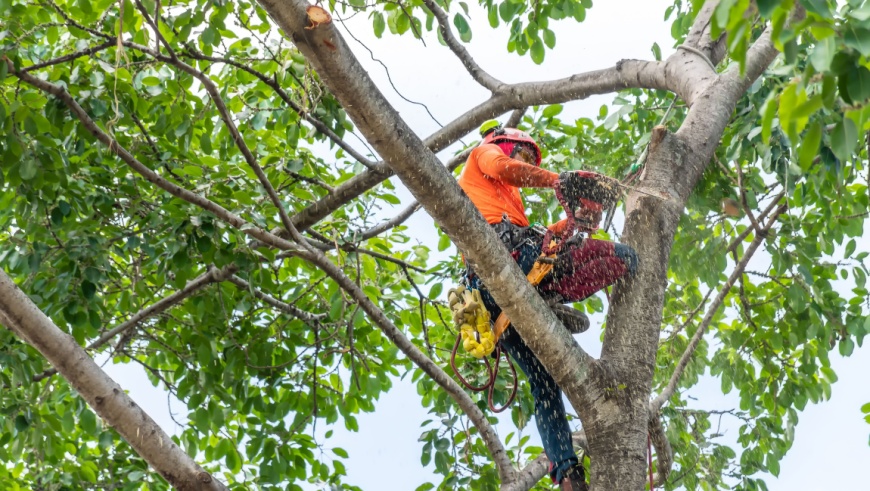
How Much is Tree Pruning?
The average cost of tree trimming and pruning will depend on various factors. These include the size of the tree, the type and extent of the pruning, location within the UK and access to the tree.
It will also depend on how many trees need to be trimmed. When agreeing prices, you should also consider how the waste will be dealt with, by you or the tree surgeon. A professional arborist or tree surgeon will never work alone, and it is common practice for teams of two or three to attend a job. This is for practical as well as safety reasons.
So, how much does it cost?
As a result, the price of labour will potentially be high but will depend on the extent and scope of the work required at each individual job. A daily rate of £150-£200 per day per tradesperson will add up to £450-£600 per day for a two or three-person team.
Tree trimming services encompass many different types of pruning, and the costs will vary according to which type is being done. Crown lifting involves removing lower branches, thereby lifting the canopy of the tree. This process can take between half a day to two days depending on the size of the tree, and this tree trimming cost may be between £250-£1,000.
Crown thinning reduces the crown's density by removing a percentage of the branches from the canopy. The extent of the thinning, the size and location of the tree will also be a factor in the cost. This practice is particularly useful for pruning apple trees. Depending on the trees' size and number, it may take 1-2 days and cost between £350-£1,000.
Crown reduction or reshaping is another typical tree trimming service. Its purpose is the alter the shape, height or spread of the tree.
This is often done to reduce the weight load on the tree, particularly if it is in decline. For a small tree, this job can be done in a day, but it could take 2-3 days for larger trees. The costs for crown reduction can be between £350-£1,500 depending on the tree's size and accessibility.
Dead wooding or crown cleaning is exactly what it sounds like. It is the removal of dead or diseased branches by cutting branches back to healthy growth. This is important for the vitality of the tree and safety to prevent dead or decayed branches from falling from the canopy during high winds or storms.
Depending on the extent of the decay or diseased wood and the tree's size, the cost for crown cleaning may be between £500-£1,500. Formative pruning is done when a tree is quite young, and its purpose is to strengthen the branches of a tree, particularly fruit trees to allow them to bear the weight of fruit crops. As these trees are usually more accessible, the cost to prune them is slightly less.
Of course, if you have several fruit trees, the cost will increase, but the average cost for this service is between £250 and £700. Pollarding is an extreme form of tree trimming and involves cutting the branches back to the tree's trunk and forming a 'knuckle'. This is typically done on broadleaf trees on a three to four-year cycle and is used to keep the tree in an easy to maintain shape.
The price of pollarding will depend on the size, location, and accessibility of the tree but on average this tree trimming cost may be between £500-£1,000. So, as we can see the cost of tree trimming and pruning will be significantly affected by the size, type, location, and ease of access to the tree. The type of equipment used will also have a bearing on the overall cost as will the number of trees requiring work.
Tree Cutting Prices
Below is a table showing the average cost of tree trimming and pruning for a medium to large tree. Prices will vary according to location.
| TYPE OF TREE TRIMMING | DURATION | Average Cost |
|---|---|---|
| Formative pruning | 1/2 - 1 day | £250-£700 |
| Dead wooding/crown cleaning | 1-3 days | £500-£1,500 |
| Crown lifting | 1-2 days | £250-£1,000 |
| Crown thinning | 1-2 days | £350-£1,000 |
| Crown reduction & reshaping | 1-3 days | £350-£1,500 |
| Pollarding | 1-2 days | £500-£1,000 |
Supply Costs
Below are the average costs for the equipment needed to carry out tree trimming and pruning if you do not hire a professional and wish to do the work as a DIY project.
| TREE TRIMMING EQUIPMENT | AVERAGE COST |
|---|---|
| Chain saw | £250-£700 |
| Pole saw (reach saw) | £100-£200 |
| Pruning saw | £10-£50 |
| Loppers | £15-£130 |
| Pruning shears | £10-£90 |
| Wood chipper (to buy) | £400-£1400 |
| Wood chipper (to hire) | £60 per day |
| Wood chipper (to hire) | £80 per weekend |
Table of Contents
- How is tree pruning?
- Labour costs and time frames
- Cost affecting factors of tree trimming and pruning
- What does tree trimming and pruning entail?
- DIY tree trimming and pruning
- Building regulations for tree trimming and pruning
- Planning permission for tree trimming and pruning
- FAQs
- How to find & hire a tree specialist
- Sources
Additional Costs
If trimming a tree in your garden is part of a project to fix your outside space, then there may be other jobs you want to add.
Making your garden tidy and pleasing to look at will increase your enjoyment of it and add to your property's saleability should you decide to move.
Removing a Tree
You may decide not to trim or prune the tree but remove it altogether. This is not really a job for a DIY project on the weekend with all the inherent risks associated with it.
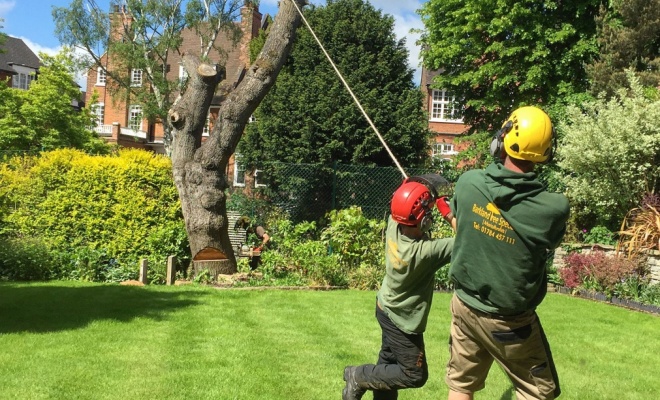
Therefore, getting a professional tree surgeon or arborist in to fell the tree is the sensible solution. The cost to remove a tree will depend on its size and condition, your location and ease of access to the site.
Considering all these factors, you could pay between £250-£2,000 to remove a tree.
Cost of Removing a Tree Stump
You may decide to remove a tree but be left with the tree stump, and getting rid of it can be tricky. While a small stump of 5-6 inches can probably be dug up the same is not true for anything much bigger than that.
It is also possible to burn or chemically treat a tree stump to remove it. These are slow processes, and many people do not like using chemicals in the garden, particularly with young children or pets around.
The preferred method for removing a tree stump is by grinding with specialist equipment and costs between £80-£350 for a stump larger than 6 inches.
Lawn Fertilisation
The need to keep your lawn looking good and healthy means that it will need to be fertilised at least twice a year. As the grass is cut so regularly during the growing season, it is important to feed it so that it can recover and regrow.
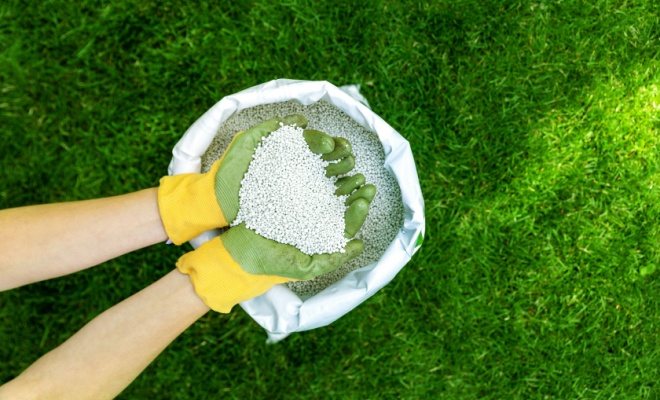
Heavily used lawns may need to be fertilised more than twice a year and may benefit from quarterly treatments. The cost of lawn fertilisation as a twice-yearly treatment is approximately £90-£100.
Hiring a Gardener for Maintenance
To keep your garden looking good all year round you could employ the services of a maintenance gardener.
Of course, the price you will pay for a regular gardener will depend on your garden's size, the type of work that will be done, and your location.
For routine maintenance such as grass cutting, hedge trimming and weeding, most gardeners charge on average £25-£30 per hour.
Cost Breakdown Calculator
Individual costs for hiring a tree surgeon to trim a 25ft tree and remove waste - Total Cost: £450
Materials
£50
Tradesmen
£350
Waste
£50
Labour Costs and Time Frames
Most tree surgeons or arborists will not have fixed prices as the costs will vary according to each job's needs. Tree trimming and pruning prices will consist largely of labour charges as the job is a very physical process.
The labour charges also include the use of any equipment in order to complete the necessary work.
What are the Labour Costs?
As an arborist typically has to climb into the tree to access branches to be cut as well as carry their equipment, the labour prices are the largest proportion of the pruning cost. It is a very dangerous profession, and there is a significant safety element that must be taken into account.
This applies to the arborist in the tree doing the cutting and pruning and his team members on the ground. Due to its high-risk nature, professional tree surgeons will work in teams of two or three, raising the labour costs significantly.
When the arborist trims the tree, the cut piece is either allowed to fall to the ground or is lowered by ropes depending on the size and the particular situation. The safe removal of the branches is of course only one part of the job, albeit an important one, along with cutting boughs and clearing and disposing of them away from the site.
Some companies will have a wood chipper and trailer so that this can be done as the branches are cut down, or they can be taken away whole or left with the homeowner. Whichever option is chosen the labour involved in the clean up is quite extensive.
Timeframes for Tree Trimming
The timeframe for tree trimming will depend on the number and size of trees involved and the type of pruning required. One easily accessible tree needing a crown lift will take less time than a number of trees that need crown thinning or reduction.
Crown Lifting
Crown lifting a single tree can take as little as a couple of hours, but that does not include the clean-up, removal and disposal of the resulting cut branches which may take the same amount of time again.
Crown Reduction
Crown reduction or thinning is more involved as the arborist needs to climb into the tree and work their way around the canopy removing branches with skill and care.
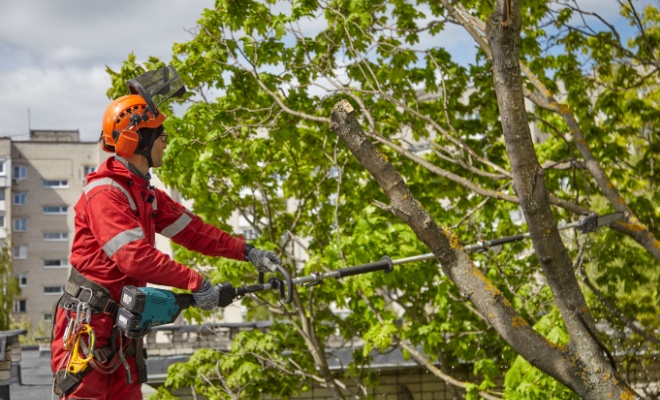
These cut branches then need to be lowered to the ground and later disposed of. This can take a day for a large tree, and if there is more than one, the timeframe will increase accordingly.
Dead Wooding
Dead wooding a tree can be risky due to the decaying nature of some of the boughs and branches. This practice will involve the arborist climbing the tree and cutting out dead or diseased wood.
It may also include rectifying the damage done to the tree by previous bad pruning. Depending on the amount of dead wooding to be done, the process may take a day or so, including removing the cut branches.
Formative Pruning
Formative pruning is done on young trees, and these will typically be easily accessible. The pruning duration for this method will depend on the number of trees involved, but one tree may take no more than a couple of hours, including tidy up and waste removal.
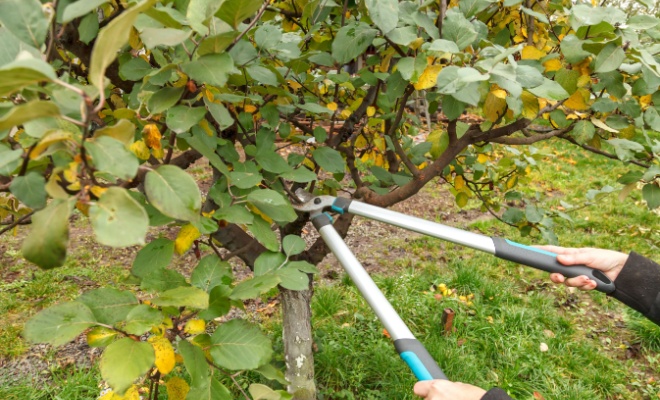
Pruning plum trees, apple trees or other fruit trees is important to encourage the energy of the tree to go into producing fruit.
What Will Increase Labour Costs & Timeframes?
Several factors can influence the labour cost and the timeframe of tree trimming and pruning.
Weather
As an outdoor task, the weather can affect the work of tree trimming. Delays due to high winds or heavy rain can mean that the job will take longer and may be extended over several days.
As a lot of tree pruning is done in winter, outside of the growing season, the impact of bad weather is a real risk.
Access
Access to the tree is a factor that may increase the labour cost and make the job of tree trimming a longer process.
If the site of the tree makes it difficult to get machinery such as a cherry picker in place, it will be necessary for the tree surgeon to climb the tree which could increase the cost by extending the timeframe of the job.
Proximity to buildings or public highways may also mean that access to the tree will need to be carefully managed to prevent property damage or protect people from falling branches.
Access is not usually an issue when pruning apple trees or other fruit trees.
Size
The size of the tree being trimmed will impact the time that the work will take and the labour costs.
For a large or diseased tree that needs to be treated with care, the timeframe will be longer to safely and effectively carry out the work.
The larger or more difficult the tree, the more tradespeople will need to be on site. An arborist may need a second climber in the tree with them to help and have someone on the ground to clear debris.
Tree Preservation Order
If a tree has a preservation order as is often the case in conservation areas, then the time taken to have the tree pruned will be extended while the local authority's tree officer assesses the case.
Individual trees and groups of trees or woodland can be subject to tree preservation orders that can apply to any species of tree.
Cost Affecting Factors of Tree Trimming and Pruning
The things that will affect the costs of tree pruning will be the type of trimming or pruning, the size and type of the tree as well as ease of access and the location of the property.
Type of Tree Trimming or Pruning
There are several different tree trimming and pruning methods, and each will have a specific function to deal with issues in maintaining trees.
Crown Lifting
One of the main reasons for crown lifting is to allow passage underneath the boughs of the tree. The lower branches are removed, thus lifting the crown of the tree. This may be done to give vehicles access beneath the tree for vehicles to pass or even make mowing beneath a tree easier.
If a tree is close to a building and the lower branches are blocking light, then a crown lift will remove those branches and remove the shading issue. This is one of the more straightforward tree trimming jobs, and for a single, easily accessible tree should take no more than half a day and cost £250-£350.
For larger or more difficult to access trees, the cost will rise proportionately.
Crown Reduction
This process reduces the tree's height and spread by removing the outer branches while maintaining its natural form and shape. It is often done in urban or suburban areas where a tree has become too large for its environment and may pose a danger to property or create excess shade.
Crown reduction can alleviate stress on the tree by reducing the percentage of heavy outer branches. Depending on the size and number of trees needing work crown reduction may take one or several days and cost on average from £350-£1,800.
Crown Thinning
Crown thinning involves removing a percentage of branches from the crown of a tree allowing more light into the canopy and works especially well with fruit trees.
It creates a well-balanced tree that has a less dense canopy and encourages growth. An arborist will normally need to climb the tree to access the branches to be removed and get a clear view of what needs to be achieved.
Crown thinning does not alter the height or the spread of the tree, only the density of the canopy. The work needs to be done with care and skill and as a result, may take a day for one tree so expect to pay at least £350-£450 for this service per tree.
Pollarding
This is an extreme form of pruning where the branches are cut right back to the trunk of the tree. It is a contentious practice for many people as it can create problems if not introduced early in the tree's life and has to be done in 3-4 year cycles.
There is also the threat of introducing disease through the harsh cutting and potentially weakening any new growth. From an aesthetic point of view, it does not make for an attractive sight.
However, it is widely used especially by local authorities for roadside trees to keep maintenance to a minimum and allow unhindered access for buses and other large vehicles. Pollarding a single large tree can take 1-2 days and may cost £500-£1,000.
Formative Pruning
Formative pruning is done on young trees to encourage directional growth and creates strong branches which can carry heavy fruit loads. It also promotes a healthy and well-balanced tree and aims to reduce deformation and stress on the branches by removing those that are crossing, rubbing or diseased.
As this type of pruning is done on young trees that are not normally very large it takes less time and labour, nevertheless requires expertise and skill to ensure damage is not caused to the growing and maturing tree.
Depending on the number of trees to be pruned this service may cost between £250-£700. Pruning plum trees should be done with care as if done at the wrong time of year it can cause the tree to become infected with silver leaf disease which can kill the tree.
Dead Wooding
As the name suggests this type of tree trimming involves removing dead wood from the tree, the branches are cut back to healthy growth and the dead branches removed. These may be diseased or broken branches which pose a significant threat to life and property if large enough and are referred to as 'widow makers' due to their potential risk and danger.
If you own a tree, it is your legal responsibility to ensure that it presents no threat to property or people. So, if there is dead, dying, diseased or broken branches in a tree on your property, it is important to get it professionally removed.
The cost for this service will depend on the extent of the dead wood and the risk involved in removing it but on average may cost between £500-£1,500.
Size of Tree
The size of the tree will be a determining factor in the tree trimming and pruning cost. For example, pruning plum trees as young plants will not cost the same as dead wooding a 60-foot oak tree.
Not only will the size of the tree invariably mean more work, but accessing larger trees will be more involved and cost more. The removed branches from larger trees will also involve more work to dispose of than smaller trimmings from pruning apple trees or similar.
Taller trees are more dangerous to work on and will require more time and care to trim, impacting the costs.
Type of Tree
The type of tree that requires pruning will potentially influence the cost. Leylandii which has been planted close together to form a boundary are notoriously difficult to trim as they grow so tall so quickly.
If not maintained regularly, this tree can quickly become unmanageable for the average gardener, and it may be necessary to hire a tree surgeon to trim it.
This may involve using a raised platform such as a cherry picker which will increase the cost. On the other hand, fruit trees are reasonably easy to prune and rarely get so tall that they are difficult to reach.
Ease of Access
Access to a tall tree needing to be pruned can be done by the arborist climbing the tree or from a cherry picker. Using a hydraulic platform will potentially add to the cost of the work. Smaller trees can be accessed from ground level or a specialist ladder which is shaped like a tripod with a very wide base for stability and commonly used for fruit tree pruning.
Gaining equipment access to the tree site may be difficult in urban areas, which may present problems if fence panels need to be removed or paths widened, adding to the overall cost.
Location of Property
Tree trimming and pruning prices will vary according to the location of the property. For London and the southeast, the costs will be higher due to larger overheads such as insurance or business premises.

While other parts of the country may be slightly cheaper concerning tree trimming costs, some large cities will still demand a premium for this type of service.
What Does Tree Trimming and Pruning Entail?
As there are several different types of tree trimming and pruning and much depends on the tree's needs and conditions, it is difficult to give a general description of what it entails.
However, many of the various pruning techniques are similar, so a broad understanding of what the process entails is possible.
Tree trimming is not a one size fits all type of service, and each job will be different. The formative pruning of young trees will be significantly different from a crown lift or reduction in terms of the method, time, labour, and cost.
DIY Tree Trimming and Pruning
The job of trimming or pruning trees is varied, and deciding whether to hire a professional or do the job yourself will depend on the individual job. If the only trimming you have done is Christmas tree trimming, it may be advisable to leave the pruning to a professional.

However, formative pruning to young fruit trees can be done as a DIY task with the right information and instruction. However, pruning a 60ft tree in your garden that borders a neighbour is probably best left to a professional.
Safety should be a priority, and if there is a risk of damage to the property or danger to people, then DIY tree trimming, or pruning should not be attempted.
Dangers of DIY
There are many dangers associated with DIY tree pruning. Falls from height are an obvious hazard if the pruning involves a tall tree as are falling branches. The proximity of the tree to property or passers-by, including vehicles should be considered before taking on DIY tree pruning.
Similarly, if there are power lines in the vicinity of the tree being trimmed, then this is definitely a serious danger and should not be attempted on a DIY basis.
Using power tools such as a chain saw is a risk even for experienced professionals so DIY gardeners should be extremely cautious in their use. It is certainly not wise for an untrained person to climb a tree with a chain saw.
Sharp hand tools such as pruning saws or secateurs can also cause injury and should be used with caution. Falling branches can cause crush and impact injuries.
Which Tree Trimming Jobs Can Be Done DIY?
Formative pruning is a relatively safe job that can be done as a DIY task as it is normally done on young trees that have not grown very tall.
The use of tools means that there is still a risk, but it is a relatively easy job to do yourself with care. Unless you have a whole orchard of young fruit trees to be pruned, it is also a way of keeping your tree trimming and pruning costs down.
Crown lifting a tree is also a job that can be done as a gardening DIY project. This involves cutting back the lower branches of a tree to lift the crown higher and allow more light and space around the base of the tree.
As it is only the lower branches that need to be removed for some species, this can be done from the ground or a ladder. However, if you are using a ladder, make sure that there is someone with you while you work to stabilise the ladder's base.
If you hire a professional to carry out pruning on your tree, you could take on the clean up and waste removal yourself.
Those with wood-burning stoves could store and burn the wood at a later date, or you could hire a wood chipper and use the chippings in the garden as mulch or weed suppressant. You could potentially save £100 or more on waste disposal depending on how much wood has been removed from your tree.
To carry out the tree trimming or pruning work yourself, you should be confident that you can safely do the work to a good standard in order to prevent damage to the tree. For formative pruning of a young tree or a crown lift, you could save between £250-£1,000 if you carried out the work yourself.
DIY Pruning Tools & Safety Equipment
The tools you would need for tree pruning will depend on the type of you are doing but could include:
- Pruning saw
- Secateurs
- Chainsaw
For safety, you should not work alone if you are working at height or with a chainsaw. Depending on the type of tree pruning you are carrying out you should wear:
- Safety goggles
- Gloves
- Steel capped boots
- Hard hat
The work of pruning or trimming a tree on your property does not need to be signed off by a professional unless there is a Tree Preservation Order in place.
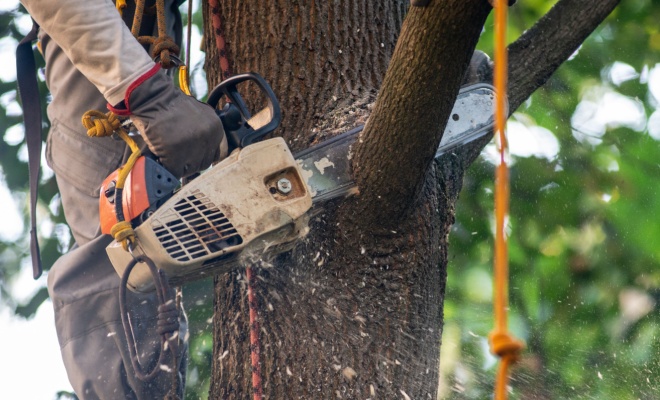
There are no specific Building Regulations in place that will impact the trimming or pruning of a tree.
Building Regulations for Tree Trimming and Pruning
There are no Building Regulations that apply to the trimming or pruning of a tree. However, some species have roots that can affect building foundations up to 20 metres away, and this should be considered when building new structures close to existing trees.
Planning Permission for Tree Trimming and Pruning
If you are unsure about a tree's status on your property that you wish to prune you should contact your local council and ask if there is a Tree Preservation Order in effect. This is usually only the case in conservation areas, but it is better to check if you are uncertain before any work is carried out.
Written consent from the local authority is required to prune a tree that is protected in this way, and failure to get this consent prior to pruning may result in a fine of up to £20,000.
When granting planning permission, a local authority must ensure that provision is made for any tree under a Tree Preservation Order. Information on trees which are protected by Tree Preservation Orders can be obtained from the local authority.
FAQs
Pruning can also be done to encourage more productive growth such as that done with fruit trees or to encourage the tree to grow in a certain direction.
However, some trees such as plum or cherry trees should be pruned in late summer after flowering.
These trees are susceptible to silver leaf disease which infects the pruning cuts with a fungus and will kill the leaves, branches and potentially the tree if not treated.
Pruning can be done for many different reasons, such as increasing the amount of fruit produced or removing dead wood while trimming is mainly an aesthetic and maintenance practice.
An arborist will understand a tree's physiology and biomechanics and, therefore, assess its defects and safety.
They are also qualified to carry out tree inspections and BS5837 surveys which form part of the planning process where trees are involved.
With large or tall trees, a tree surgeon's skills and expertise are advisable due to the safety issues involved.
Not only will a qualified tree surgeon be better equipped to deal with your tree pruning but will have the necessary insurance in place should things go wrong.
Curing is the process of preventing excessive or rapid moisture loss from the screed whilst still maintaining an ambient temperature.
Drying refers to the evaporating of surplus moisture from the floor screed without causing cracks or fractures.
How to Find & Hire a Tree Specialist
As previously stated, it is better to hire a tree specialist to prune your tree as they have the skill, experience, tools, and insurance to do the job effectively and safely.
The average cost to hire a tree specialist will depend on various factors such as the tree's size, location, and needs. Depending on these needs the average cost will be between £250-£1,800.
What to Look For
As with a lot of home improvement work personal recommendation is a good way to find a reputable contractor, so it is worth speaking to family, friends, and neighbours to see if they have had similar work done. Some local horticultural colleges, garden centres or nurseries may also be a good source of recommendation for reputable and qualified tree surgeons.
As the tree specialist will usually need to see the tree before giving a quotation for the work, you should check if there is a charge for this initial visit. Also, check if this is reimbursable if they are awarded the work.
Look for a company that is well established and has been in business for at least five years. Local reputation is a good indicator of the level of service and aftercare. Ensure that any quotation for the work involves all aspects, including the removal and disposal of the cut branches. This should be agreed before any work is done.
Look for a company that offers a follow-up service if there is an issue after they have left the site or just need some post-visit advice.
Qualifications
Tree surgeons can do a college course in Level 2 Certificate in Arboriculture or a Level 3 Diploma in Forestry and Arboriculture. Many will work alongside an experienced and qualified arborist and learn their trade on the job.
Perhaps more important than academic qualifications are the more practical ones such as:
- A head for heights
- Physical fitness
- Enjoying working outdoors
- Practical and good with manual labour
- Be able to work safely within specific regulations
- Good communication skills
Experience
When you want to hire a tree specialist to prune your tree, you will want to know that they have the relevant practical experience in tree surgery and maintenance. The more extensive the experience the tree surgeon or arborist has the more confidence you can have in their ability to deal with your project.
A professional tree specialist should be able to provide references from previous clients.
Accreditation
The Arboricultural Association is the only comprehensive accreditation scheme for tree surgeons and arborists in the UK.
They approve contractors who demonstrate high levels of skill and knowledge. These contractors must uphold the Arboricultural Association's standards, codes of ethics and professional conduct.
Insurance
Any person carrying out work in or on your property should have sufficient and appropriate insurance. It is your responsibility to check that this is the case and ask for proof if necessary.
Public liability insurance protects against accidents, damage to property or injury to members of the public as a result of work done by the tree surgeon or arborist. Professional indemnity insurance protects against claims resulting from loss associated with omissions or errors from advice received by clients from the tree surgeon or arborist.
Sources
https://www.trees.org.uk/Help-Advice/Help-for-Tree-Owners/Guide-to-Tree-Pruning
https://blog.fantasticgardeners.co.uk/how-much-do-tree-surgeons-charge-in-uk-on-average/
https://www.thorstrees.co.uk/services-tree-surgery-maintenance/
https://www.woodlands.co.uk/blog/woodland-activities/a-guide-to-tree-pruning/
https://forums.moneysavingexpert.com/discussion/2443361/tree-pruning-costs
https://thtreeservices.co.uk/how-much-does-tree-surgery-cost/
https://www.planningportal.co.uk/info/200130/common_projects/53/trees_and_hedges/2










